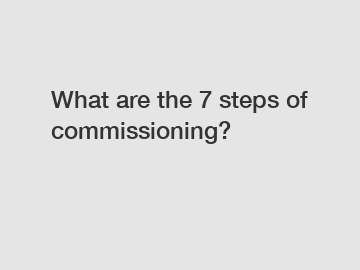What are the 7 steps of commissioning?
If you're new to the world of commissioning, you may be wondering what exactly the process entails. Commissioning is a crucial step in ensuring that a project runs smoothly and meets all necessary requirements. In this article, we'll break down the 7 steps of commissioning in a simple and easy-to-follow manner.
Step 1: Define Scope and Objectives.
The first step in the commissioning process is to clearly define the scope of the project and establish the objectives. This involves identifying the goals of the project, as well as outlining the specific tasks and responsibilities of each party involved.

Step 2: Select a Commissioning Agent.
Next, you'll need to select a commissioning agent to oversee the process. This individual or team will be responsible for coordinating all aspects of the commissioning process, from planning to execution.
Step 3: Develop a Commissioning Plan.
Once you have a commissioning agent in place, it's time to develop a detailed commissioning plan. This plan will outline the specific steps that need to be taken to ensure that the project is completed successfully and on time.
Step 4: Review Design and Construction Documents.
Before any work can begin, it's important to review the design and construction documents to ensure that they align with the project's objectives. This step helps to identify any potential issues or discrepancies that need to be addressed before moving forward.
Step 5: Implement Commissioning Activities.
With the plan in place and the documents reviewed, it's time to implement the commissioning activities. This may include testing equipment, verifying systems performance, and conducting training sessions for project personnel.
Step 6: Verify Performance and Document Results.
Once the commissioning activities have been completed, it's important to verify the performance of the systems and document the results. This step helps to ensure that everything is functioning as intended and that any issues are addressed promptly.
Step 7: Handover and Ongoing Support.
The final step in the commissioning process is to hand over the completed project to the client and provide ongoing support as needed. This may involve training staff on how to operate and maintain the systems, as well as addressing any post-commissioning issues that may arise.
In conclusion, commissioning is a critical step in ensuring that a project is completed successfully and meets all necessary requirements. By following these 7 steps, you can streamline the process and set the stage for a smooth and efficient project delivery.
If you're interested in learning more about commissioning or need assistance with your project, don't hesitate to contact us. Our team of experienced commissioning professionals is here to help you every step of the way. Whether you're a client or a supplier, we're here to support you in achieving your goals.
For more information, please visit Flange Management Process, Retro Jetting, Sub-sea Pipeline Testing News.
247
0
0

Comments
All Comments (0)